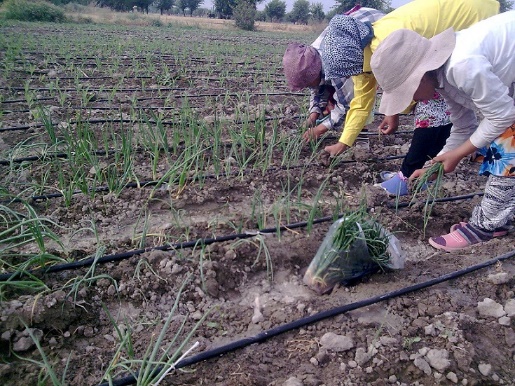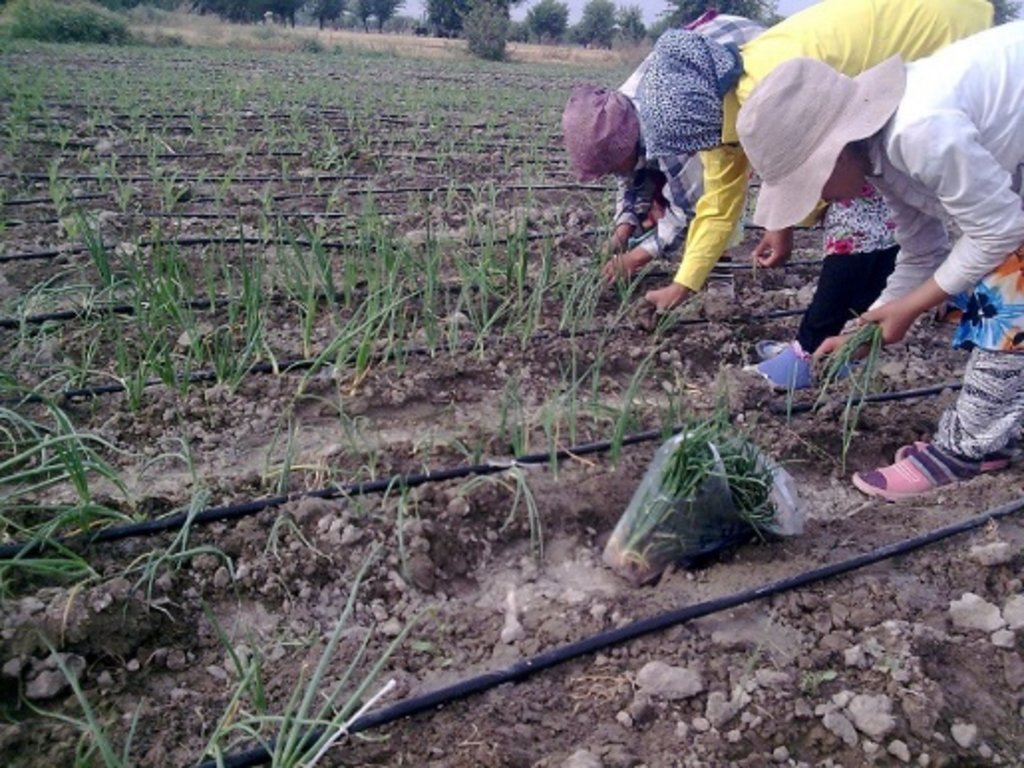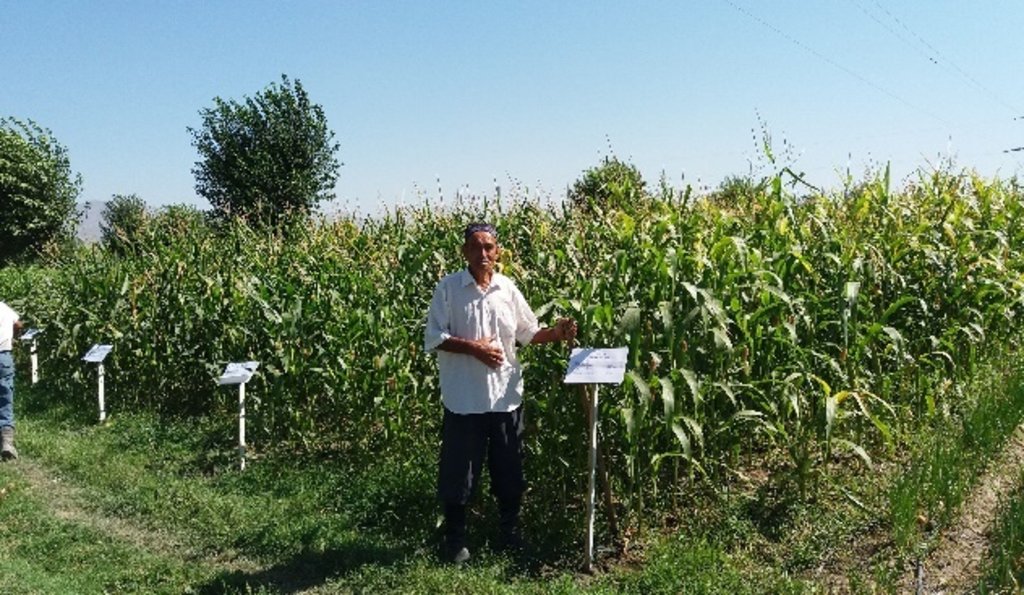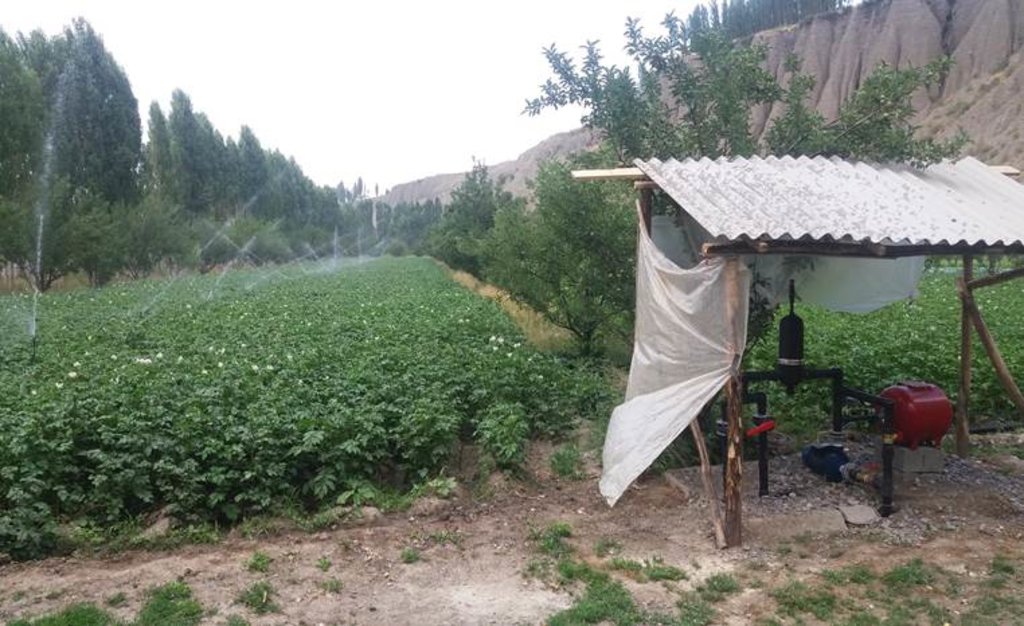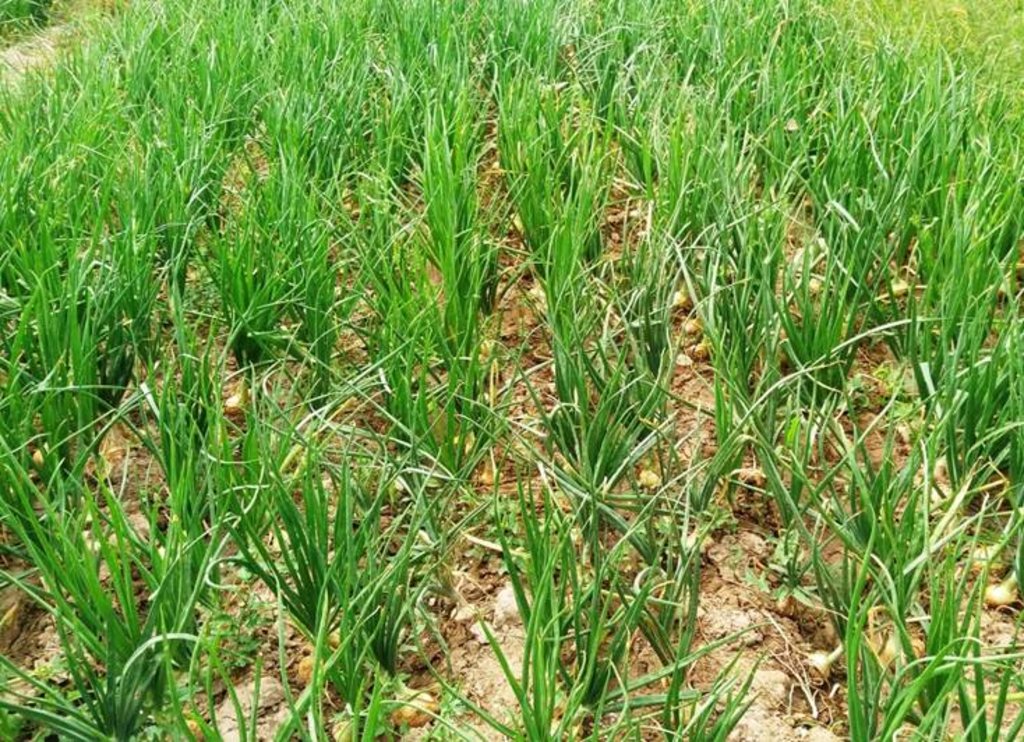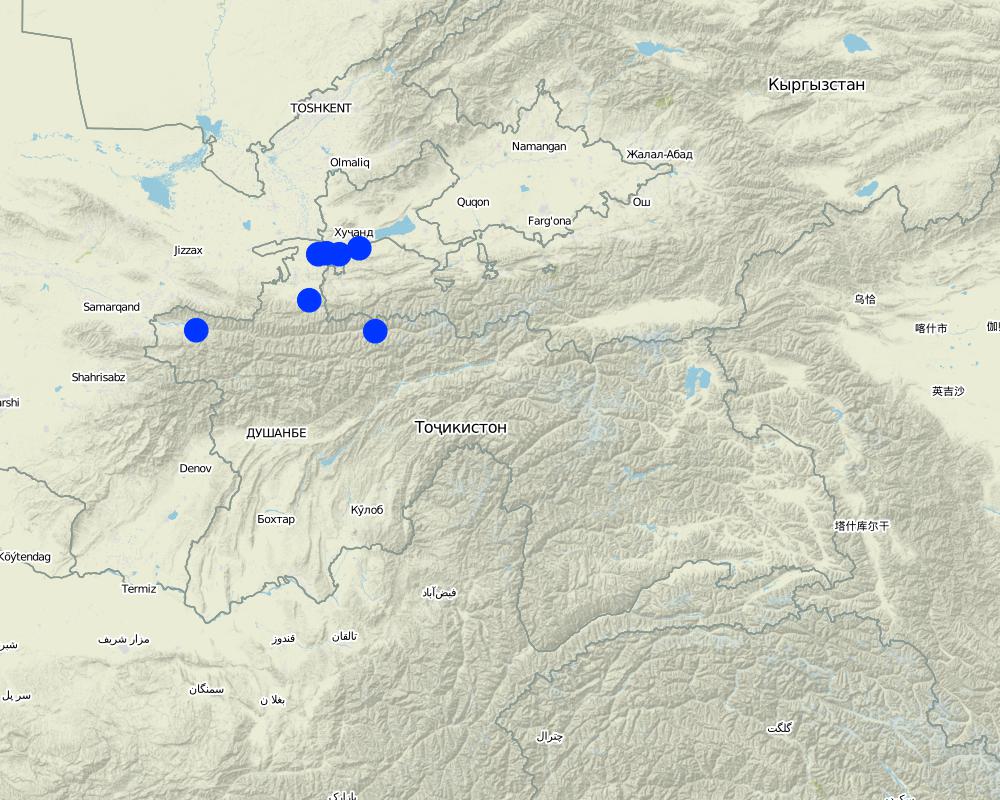Integrated farming on irrigated lands for adaptation to changing climate [塔吉克斯坦]
- 创建:
- 更新:
- 编制者: Stefan Michel
- 编辑者: –
- 审查者: Umed Vahobov
Интегрированное ведение земледелия на орошаемых землях для адаптации к изменению климата
approaches_4316 - 塔吉克斯坦
查看章节
全部展开 全部收起1. 一般信息
1.2 参与方法评估和文件编制的资源人员和机构的联系方式
关键资源人员
SLM专业人员:
Negmatov Negmatjon
negmatdzhon.negmatov@giz.de
Deutsche Gesellschaft für Internationale Zusammenarbeit (GIZ)
塔吉克斯坦
有助于对方法进行记录/评估的项目名称(如相关)
Strengthening of Livelihoods through Climate Change Adaptation in Kyrgyzstan and Tajikistan有助于对方法进行记录/评估的机构名称(如相关)
Deutsche Gesellschaft für Internationale Zusammenarbeit - Tajikistan (GIZ Tajikistan) - 塔吉克斯坦1.3 关于使用通过WOCAT记录的数据的条件
(现场)数据是什么时候汇编的?:
29/11/2018
编制者和关键资源人员接受有关使用通过WOCAT记录数据的条件。:
是
1.4 SLM技术问卷的参考
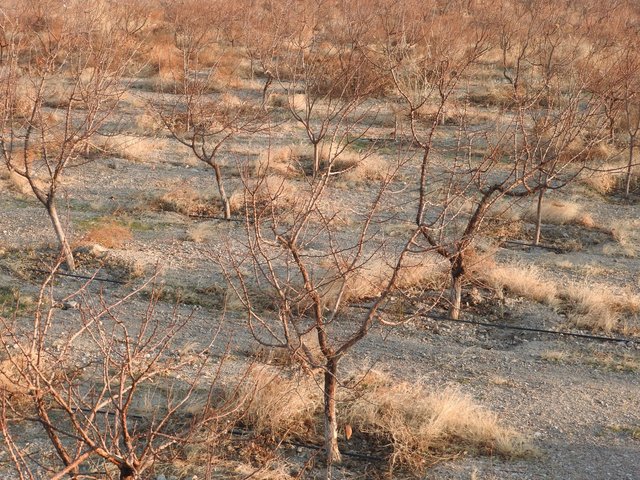
Applying drip irrigation for efficient irrigation water use … [塔吉克斯坦]
Drip irrigation substantially saves water compared to conventional furrow irrigation. Here the technology is applied for different perennial and annual crops and with use of different sources of water.
- 编制者: Stefan Michel
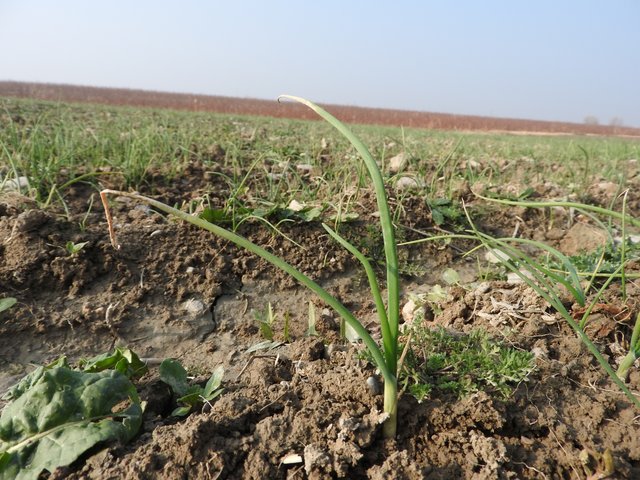
Onion production by greenhouse propagation and transplantation [塔吉克斯坦]
Onion seeds are sown in sheeting greenhouses, where the onion seedlings are propagated. The seedlings are then replanted in the open field. This makes them less prone to extreme weather events and provides higher yield of better quality.
- 编制者: Stefan Michel
2. SLM方法的描述
2.1 该方法的简要说明
Irrigated agriculture faces challenges from climate change impact and growing competition for irrigation water. The approach to get "more crop per drop" reduces the adverse effect of these impacts and improves the income of farmers.
2.2 该方法的详细说明
该方法的详细说明:
Irrigated cultivation of onion, potatoes, corn and other crops is hampered by poor agricultural practice and these challenges are increasingly exacerbated by the impact of climate change. The already visible trends and predictions show higher levels of aridity, higher temperatures during the vegetation season, reduced overall precipitation in catchment areas, more irregular rainfall patterns, reduced snow packs and accelerated snow melt as well as the loss of glaciers as buffers of water flow. These factors all cause a reduction of available irrigation water, while higher temperatures and expansion of irrigated agriculture – partly also caused by increasing aridity and reduced feasibility of rain-fed farming – lead to higher irrigation water demand. At the same time irrigated agriculture has low irrigation water use efficiency in terms of yield, crop quality and created income.
Other problems in irrigated cultivation of onion, potatoes, corn and other crops are caused by poor agricultural practice. Crop varieties producing high yield of good quality under the local conditions are not available for local farmers. Insufficient knowledge about the use of agrochemicals, difficult access to these and financial shortages experienced by farmers during the time of planting and growing of crops cause the inadequate application of fertilizer and pesticides and cause crop losses and quality issues. Only wealthy farmers are able to purchase timely sufficient amounts of agricultural inputs. Most farmers apply insufficient amounts and inadequate combinations of fertilizers, thus causing a declining soil fertility, which affects quantity and quality of harvested crops. Unreliable harvest amounts and inconsistent quality reduce the marketability of the agricultural products and cause low income levels of farmers, again affecting their ability to work their lands effectively and sustainable. Additionally, a policy of “one village – one product” has contributed to higher risks in cases of crop failure or production exceeding demand.
The approach aims at reducing these risks and obstacles in an integrated way under consideration of ongoing trends and predicted impacts of climate change. The approach therefore combines several elements through an agricultural extension service:
•Agricultural extension service providing tailored assistance to the farmers;
•Provision of agricultural inputs through the extension services to ease the application of technical advice and reduce transaction costs for the farmers;
•Packages of agricultural inputs include seeds/planting material, fertilizers and pesticides as well as growth regulator with the instruction for their correct use;
•The agricultural extension service provides access to crop varieties, which are adapted to the local site conditions and produce reliable high yields of best quality;
•Agricultural inputs are provided to farmers on a part loan basis by the extension service: farmers pay 50% of the costs of the package when purchasing, the remaining 50% are paid after harvest, with a zero interest rate (the extension service buys the inputs at bulk price and sells them to the farmers at retail price, which is 115% of the bulk price);
•Technological assistance includes the use of seeding machines and cultivation technology like the transplanting of pre-grown seedlings of onion or rice;
•Farmers are advised to diversify their crops in accordance to the local site conditions and market demand.
Additionally the project has assisted with testing and demonstration of different irrigation technologies, e.g. drip irrigation in various crops and sprinkler irrigation in potato cultivation. The result of these trials are used by the agricultural extension service to advise farmers under what site conditions, costs of irrigation water and other inputs, expected yields and predicted market demand the application of such costly irrigation techniques can be economically reasonable.
2.3 该方法的照片
2.5 采用该方法的国家/地区/地点
国家:
塔吉克斯坦
区域/州/省:
Sughd region
有关地点的进一步说明:
B. Gafurov, J. Rasulov, Spitamen, Devashtich and Panjakent districts
Map
×2.6 该方法的开始和终止日期
若不知道准确的年份,请注明该方法的大致开始日期。:
不到10年前(最近)
2.7 方法的类型
- 基于项目/方案
2.8 该方法的主要目的/目标
Improved agricultural productivity in terms of yields and quality under conditions of climate change.
2.9 推动或妨碍实施本办法所适用的技术的条件
财务资源和服务的可用性/可得性
- 阻碍
Farmers have difficulties to afford agricultural inputs at the beginning of the growth season. This issue is addressed in the approach through part loans.
机构设置
- 启动
Agricultural extension service collaborates with GIZ and was ready to jointly develop and adopt the approach.
3. 相关利益相关者的参与和角色
3.1 该方法涉及的利益相关者及其职责
- 当地土地使用者/当地社区
Farmers
Applying the approach on their lands.
- SLM专家/农业顾问
Agricultural experts
Providing technical advice.
- NGO
NGO Neksigol
Agricultural extension service - advisory role.
- 私营部门
Neksigol Group of Companies
Provider of agricultural inputs.
- 地方政府
Agricultural department of Devashtich district, Agricultural departments of other districts
Interested in improvement of agricultural production and resulting well-being of the local population and economic prosperity of their districts. Political backing and support, provision of information, facilitation of contacts.
- 国际组织
Deutsche Gesellschaft für Internationale Zusammenarbeit (GIZ)
Implementation of the project on behalf of the German government.
如果涉及多个利益相关者,请注明领导机构:
Deutsche Gesellschaft für Internationale Zusammenarbeit (GIZ)
3.2 当地土地使用者/当地社区参与该方法的不同阶段
| 当地土地使用者/当地社区的参与 | 指定参与人员并描述活动 | |
|---|---|---|
| 启动/动机 | 互动 | Discussion of testing of elements of the approach on their lands |
| 计划 | 互动 | Discussion of testing of elements of the approach on their lands |
| 实施 | 互动 | Applying elements of the appraoch on their lands |
| 监测/评估 | 互动 | Recording of yield and crop quality, reporting experiences in applying the elements of the approach. |
3.4 有关SLM技术选择的决策
具体说明谁有权决定选择要实施的技术:
- 主要是SLM专家,咨询土地使用者之后
明确做出决策的依据:
- 对充分记录的SLM知识进行评估(基于证据的决策)
- 研究结果
- 个人经验和意见(无记录)
4. 技术支持、能力建设和知识管理
4.1 能力建设/培训
是否为土地使用者/其他利益相关者提供培训?:
是
明确受训人员:
- 土地使用者
培训形式:
- 示范区域
- 课程
4.2 咨询服务
土地使用者有权使用咨询服务吗?:
是
指明是否提供了咨询服务:
- 在土地使用者的土地上
- 在固定中心
4.3 机构强化(组织发展)
是否通过这种方法建立或加强了机构?:
- 是,少许
具体说明机构的强化或建立程度:
- 本地
说明机构、角色和职责、成员等。:
Agricultural extension service and provider of agricultural inputs expanded their fields of work and their reach of farmers.
具体说明支持类型:
- 财务
- 能力建设/培训
4.4 监测和评估
监测和评估是该方法的一部分吗?:
是
注释:
Documentation of yields and quality of harvest, recording of inputs.
若是,该文件是否用于监测和评估?:
否
4.5 研究
研究是该方法的一部分吗?
否
5. 融资和外部物质支持
5.1 该方法中SLM组成部分的年度预算
如果不知道准确的年度预算,请给出一个范围:
- 10,000-100,000
注释(例如主要的资助来源/主要捐助者):
Government of Germany, implemented via Deutsche Gesellschaft für Internationale Zusammenarbeit (GIZ). The approach has been implemented in the frame of a much larger program and the specific budget for the SLM component of the Approach cannot be determined.
5.2 为土地使用者提供财政/物质支援
土地使用者是否获得实施该技术的财政/物质支持?:
是
如果是,请具体说明支持的类型、条件和提供者:
Loan of 50% of the retail price of agricultural input packages, to be recovered after harvest at zero interest rate.
5.3 对特定投入的补贴(包括劳动力)
- 农业
| 具体说明哪些投入得到了补贴 | 程度如何 | 对补贴做出具体说明 |
|---|---|---|
| 种子 | 部分融资 | Loan of 50% of the retail price of agricultural input packages, to be recovered after harvest at zero interest rate. |
| 化肥 | 部分融资 | Loan of 50% of the retail price of agricultural input packages, to be recovered after harvest at zero interest rate. |
如果土地使用者的劳动力是一项重要的投入,那么是不是:
- 自愿
注释:
Work on their own fields for their own income generation.
5.4 信用
是否根据SLM活动的方法给予信用值?:
是
对条件(利率、回报等)进行具体说明:
Loan of 50% of the retail price of agricultural input packages, to be recovered after harvest at zero interest rate. (The extension service buys the inputs at bulk price and sells them to the farmers at retail price, which is 115% of the bulk price.)
请具体指明授信方:
Agricultural extension service / provider of agricultural inputs.
请具体指明信贷接收人:
Farmers
5.5 其它激励或手段
是否有其他激励措施或工具用于促进SLM技术的实施?:
是
如果是,请具体说明:
The combination of advisory service, provision of a complete package of inputs and financial support (loan).
6. 影响分析和结论性陈述
6.1 方法的影响
该方法是否有助于当地土地使用者,提高利益相关者的参与度?:
- 否
- 是,很少
- 是,中等
- 是,支持力度很大
Participating farmers increased their confidence and status.
这种方法是否有助于基于证据的决策?:
- 否
- 是,很少
- 是,中等
- 是,支持力度很大
The direct link between the quality of agricultural input and practices and resulting yield and crop quality became visible.
该方法是否帮助土地使用者实施和维护SLM技术?:
- 否
- 是,很少
- 是,中等
- 是,支持力度很大
The farmers were enabled to apply technical advice from the extension service as agricultural inputs were made easier available and affordable.
该方法是否调动/改善了使用财务资源实施SLM的途径?:
- 否
- 是,很少
- 是,中等
- 是,支持力度很大
Farmers were enabled through a part loan to purchase input packages.
该方法是否提高了土地使用者实施土地管理的知识和能力?:
- 否
- 是,很少
- 是,中等
- 是,支持力度很大
Provision of targeted extension.
该方法是否提高了其他利益相关者的知识和能力?:
- 否
- 是,很少
- 是,中等
- 是,支持力度很大
Involved extension service and agricultural departments gained knowledge.
该方法是否建立/加强了机构、利益相关者之间的合作?:
- 否
- 是,很少
- 是,中等
- 是,支持力度很大
Existing collaboration between farmers, extension services and agricultural departments consolidated.
该方法是否改善了粮食安全/改善了营养?:
- 否
- 是,很少
- 是,中等
- 是,支持力度很大
Increase in yields and crop quality.
该方法是否改善了市场准入?:
- 否
- 是,很少
- 是,中等
- 是,支持力度很大
More reliable quantities and quality of crop allow improved market access.
该方法是否会带来就业、收入机会?:
- 否
- 是,很少
- 是,中等
- 是,支持力度很大
Higher yields and better marketability increase incomes of farmers. Demand for inputs improves business and employment opportunities of provider of inputs.
6.2 土地使用者实施SLM的主要动机
- 增加生产
- 增加利润(能力),提高成本效益比
6.3 方法活动的可持续性
土地使用者能否维持通过该方法实施的措施(无外部支持的情况下)?:
- 不确定
若否或不确定,请具体说明并予以注释:
Many farmers will not be able to purchase the package of advise and inputs without loan support. Such loans are currently not available from commercial financial institutions at affordable conditions.
6.4 该方法的长处/优点
| 土地使用者眼中的长处/优势/机会 |
|---|
| Improved crop production. |
| 编制者或其他关键资源人员认为的长处/优势/机会 |
|---|
| Improved crop production. |
| Increased crop per amount of irrigation water. |
| Preservation of soil fertility. |
6.5 该方法的弱点/缺点以及克服它们的方法
| 土地使用者认为的弱点/缺点/风险 | 如何克服它们? |
|---|---|
| High costs of inputs can by most farmers only be met with loan, at better conditions than typical commercial loans. | Loans at affordable conditions. |
| 编制者或其他关键资源人员认为的弱点/缺点/风险 | 如何克服它们? |
|---|---|
| High costs of inputs can by most farmers only be met with loan, at better conditions than typical commercial loans. | Loans at affordable conditions. |
7. 参考和链接
7.1 方法/信息来源
- 实地考察、实地调查
- 与土地使用者的访谈
- 与SLM专业人员/专家的访谈
链接和模块
全部展开 全部收起链接

Applying drip irrigation for efficient irrigation water use … [塔吉克斯坦]
Drip irrigation substantially saves water compared to conventional furrow irrigation. Here the technology is applied for different perennial and annual crops and with use of different sources of water.
- 编制者: Stefan Michel

Onion production by greenhouse propagation and transplantation [塔吉克斯坦]
Onion seeds are sown in sheeting greenhouses, where the onion seedlings are propagated. The seedlings are then replanted in the open field. This makes them less prone to extreme weather events and provides higher yield of better quality.
- 编制者: Stefan Michel
模块
无模块


